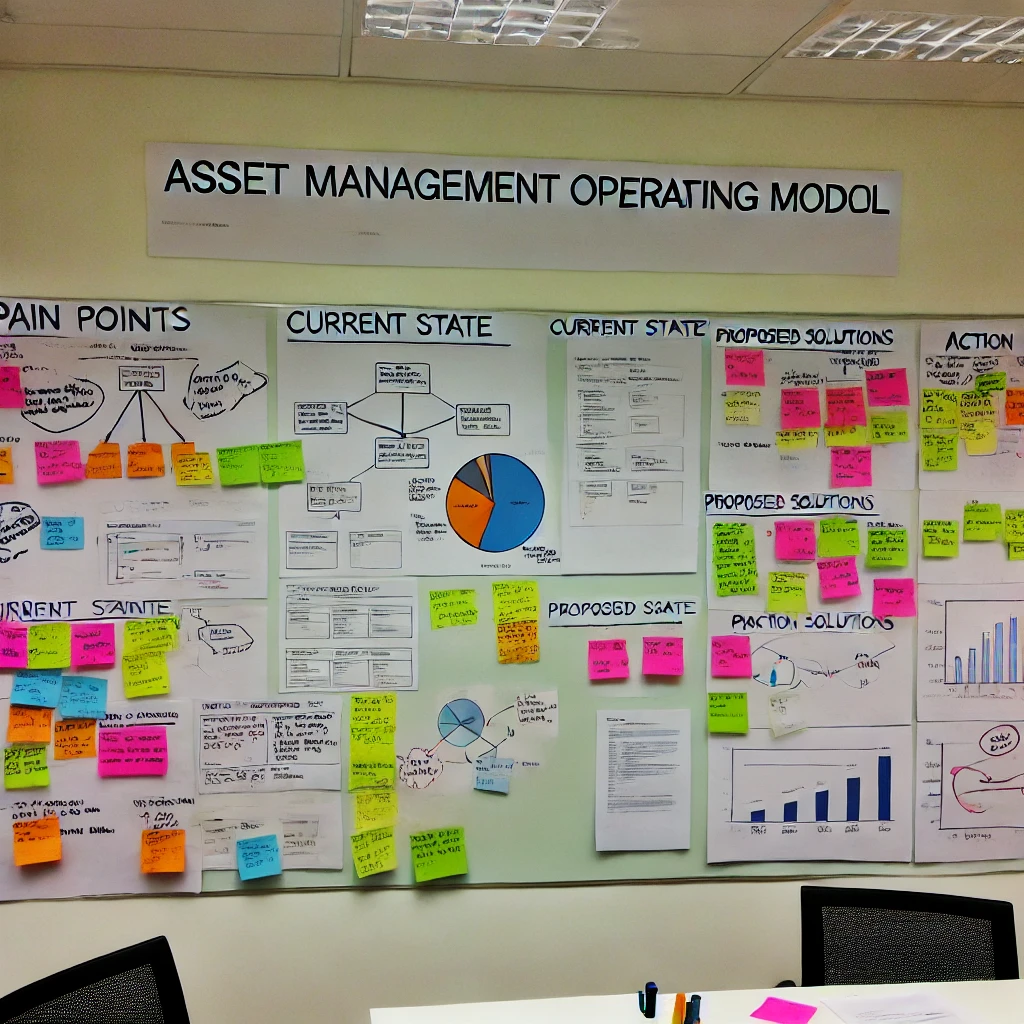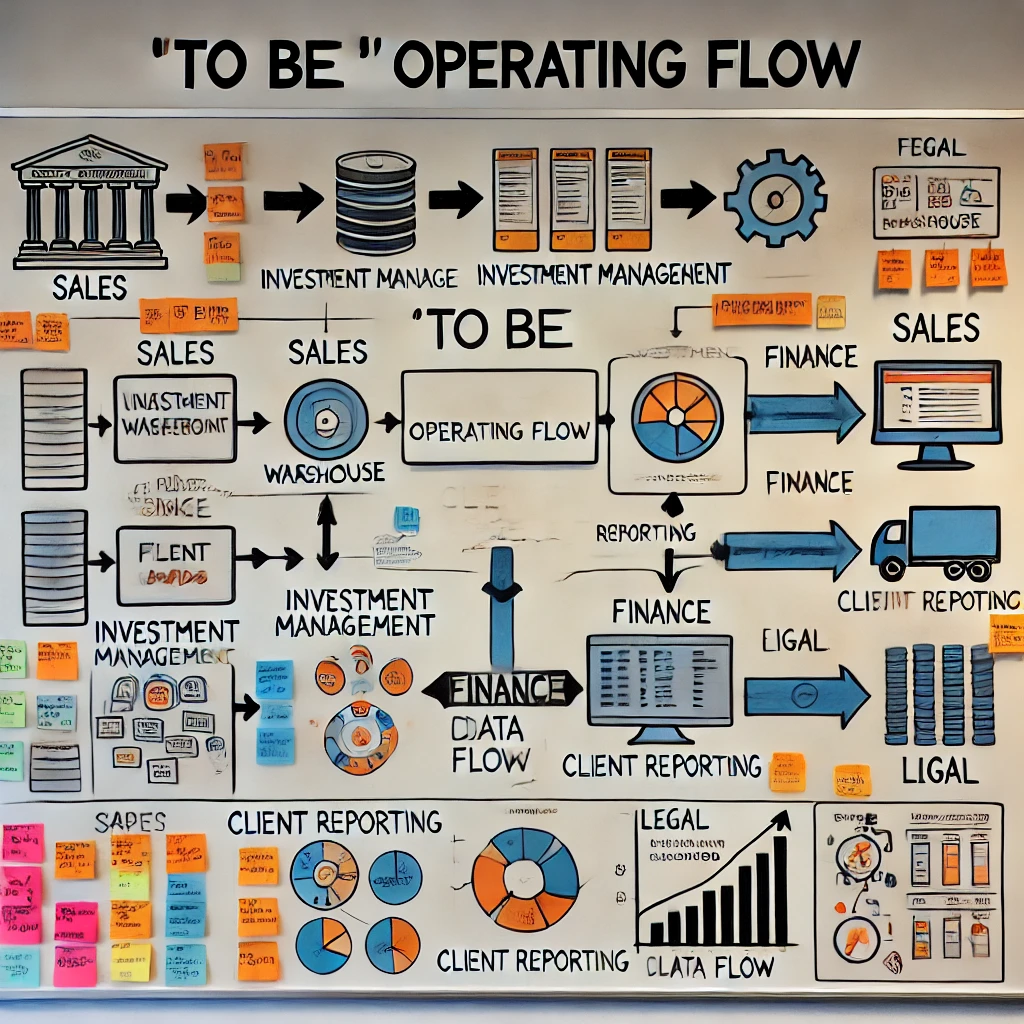An Asset Management Operating Model that Maximises Investment Efficiency whilst Meeting Regulations
A leading asset management firm sought our expertise to adjust their Target Operating Model (ToM) for compliance with post-Brexit and MiFID II regulations. Upon engaging with various teams, we discovered significant flaws in their current operating model. Recognizing that layering new processes onto a broken operating model, would be ineffective, we proposed a change in scope. Despite initial hesitation, our detailed analysis of pain points convinced the client of the need for a broader transformation.

Our revised objective focused on enhancing operational efficiency, ensuring seamless data integration, and achieving regulatory compliance
Project Steering Group:
“We were initially unaware of any issues within our operations and skeptical about the need for changes. The analysis and clear, plain-English descriptions of our processes revealed the startling inefficiencies and breakdowns that occurred when clients entrusted us with their funds. Seeing this, we were truly shocked and realized the urgent need for transformation.”
Objective
To address a critical issue in managing Assets Under Management (AUM) by fixing the broken operating model and designing a new Target Operating Model. This transformation aimed to comply with Brexit and MiFID II regulations while fundamentally enhancing operational efficiency and seamless data integration, ensuring the firm’s core asset management functions operate at peak effectiveness.
Approach:
Front-to-Back Workshops
Stakeholder Engagement: We facilitated in-depth workshops with key stakeholders, including sales teams, investment managers, contract operations, finance, client reporting, and analysts. These sessions were designed to uncover and document their pain points comprehensively.
Pain Points Prioritization: Through our analysis, we identified that the highest priority issue was the lack of visibility for investment managers regarding client account funding. Investment Managers had to make phone calls and send emails to sales and accounts, ask for data extracts, just to find out if the client funds were in the account so they could invest it. Something they should have known in real time. This was leading to client dissatisfaction and impacting the AUM (Assets Under Management).

Front to Back Workshops
Current State Process Mapping: We meticulously mapped the existing operating flow and overlaid it with the identified pain points. This visual representation highlighted critical breakdowns and dependencies on manual processes, such as phone calls, spreadsheets, and emails, demonstrating where the information flow was compromised.
The Proposal
Data Integration Proposal: Proposed an integrated data warehouse solution to senior management to centralize data from systems like Salesforce, Charles River, thinkFolio, Markit, in house Ops and Finance systems.
Documentation: Authored detailed BRDs and User Stories to incorporate the data warehouse solution into the new ToM (Target Operating Model), ensuring alignment with the firm’s strategic goals.

This structured approach not only addressed immediate operational inefficiencies but also laid the foundation for a robust, scalable, and compliant Target Operating Model, positioning the firm for sustained success in a challenging regulatory environment.
Impact
- Enhanced Operational Efficiency: By streamlining information flow and reducing reliance on manual processes, we significantly improved operational efficiency. This optimization directly contributed to better management of Assets Under Management (AUM), enhancing the firm’s overall performance.
- Boosted Client Satisfaction: The sales team gained the ability to confidently inform clients that their funds were promptly and accurately managed by the investment team. This transparency eliminated internal blame between departments and fostered trust with clients, leading to improved client relationships and satisfaction.
- Regulatory Compliance: Our solutions ensured full compliance with Brexit and MiFID II regulations, safeguarding the firm against potential legal and financial penalties while aligning operations with the latest regulatory standards.
- Superior Data Integration: We enhanced access to critical investment information by integrating data across multiple systems. This seamless data flow enabled more informed decision-making and improved the firm’s ability to respond to client needs efficiently.
The project steering group closure statement:
“Thanks to their keen insights, we uncovered and addressed a critical issue that was not part of the original scope. Their proactive approach transformed our operating model, ensuring we met new regulatory requirements while significantly improving efficiency and data integration. The resulting enhancements have streamlined our processes and elevated client satisfaction. This experience highlighted exceptional ability to identify and solve underlying problems, delivering transformative results for our firm.”
Conclusion:
By identifying and addressing a critical issue outside the original scope, our consulting firm enabled the client to achieve significant operational improvements and regulatory compliance. The revamped operating model not only met new regulatory requirements but also streamlined processes, enhanced data integration, and boosted client satisfaction. This proactive approach allowed the asset management firm to reap substantial benefits, demonstrating our expertise in pinpointing and resolving underlying issues to deliver transformative results for our clients.
